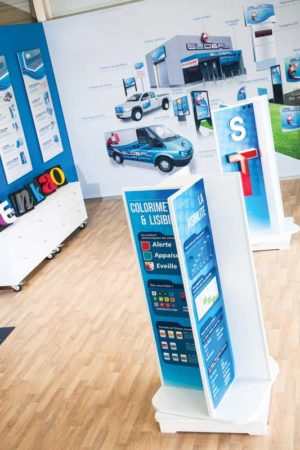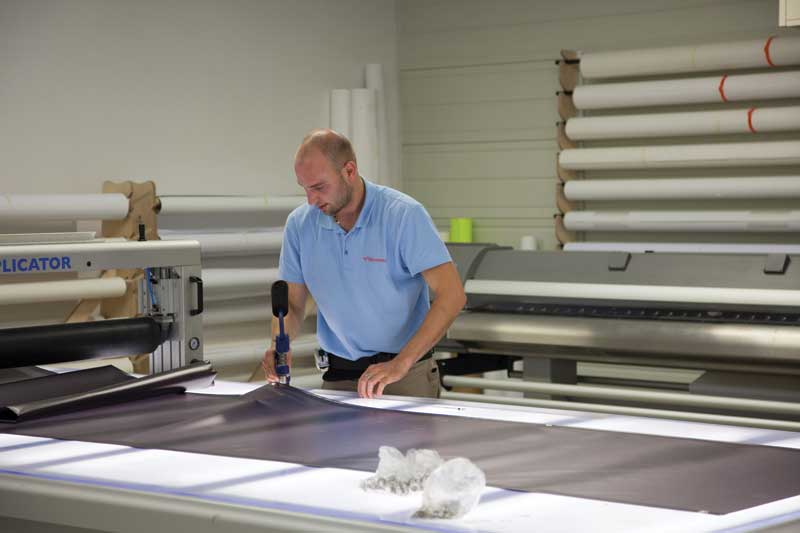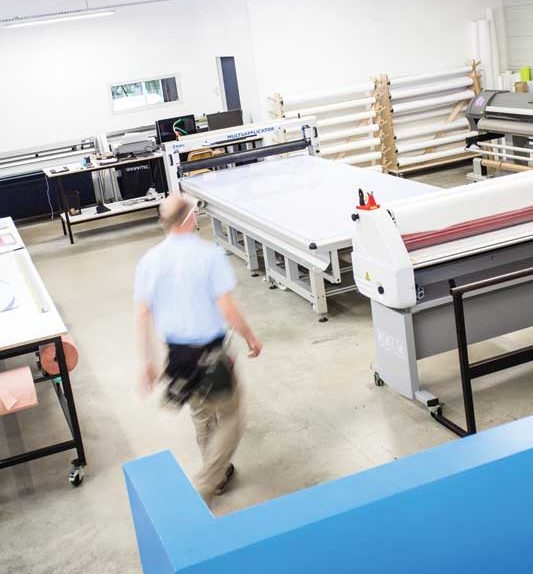Business Models: The franchising of sign shops
by all | 1 December 2016 10:15 am

Photos courtesy Gestion Per-Lac
By Pierre Lachapelle
Over the past few years, many independent sign shop owners have reassessed their position in an ever-changing and highly competitive marketplace. If they are no longer able to clearly define their target market, name their direct competitors or position themselves strategically within the industry, especially, it may be time to revisit their approach.
For some, taking this opportunity to review their business model leads them to join a franchise system, such as Signarama, Image360, FastSigns International, Signs Now or Speedpro Imaging. As an ultra-rapid consolidation of the industry continues to disrupt traditional ways of doing business among independent sign and graphics companies, more and more of them—along with print service providers (PSPs), marketing agencies, copy centres and other industry stakeholders from a variety of backgrounds—are joining forces with major franchisors to take advantage of corporate synergies and a multitude of services offered by larger, nationally and internationally integrated franchise networks.
There are many options open to them, but one that has become an increasingly important trend—both in Canada and elsewhere—is the conversion of existing sign shops into franchised businesses.
Converting or co-branding
Some franchisors have developed specialized programs to attract owners of existing sign and print shops as new franchisees by converting their businesses to operate under their national or international franchise brands. The franchisors benefit through royalty payments, while the signmakers or PSPs benefit from the help and support of a new partner in their business. Even when these shops already have a solid client base, after all, their owners may recognize the need to grow by diversifying their offerings, differentiating themselves within their local market and better positioning themselves to improve their overall business performance.
To respond to new market challenges, some simply convert their business into a franchise, while others opt for co-branding, whereby the franchise brand is added to their own. While both of these approaches have already been taken for decades in other sectors, they are still relatively new to sign shops and PSPs. With profit margins constantly being squeezed, however, and the growing need to improve operations and marketing performance, it is no wonder many independent sign business owners are now considering franchising as a development strategy.

“Since converting my business, I am better-organized and better-structured,” says franchisee Jonathan Doleans, “and this has translated into an increase in sales of more than 25 per cent!”
The benefits of membership
The advantages have quickly become clear. Industry statistics show sign shop franchisees consistently saw their business grow by between 6.65 and 16.9 per cent in 2014, for example, and were poised for additional, record-setting momentum in 2015 and 2016.
Certainly, taking advantage of a proven business system—while remaining the boss—can be an effective route for owners of sign businesses with fewer than 10 employees. Very few companies of this size are otherwise able to meet the multiple challenges of excelling in sales, marketing, administration and day-to-day operations. Implementing a conversion and adhering to a franchise system allows even the smallest business to benefit, as a team of specialists at the corporate level is working every day to improve the entire franchise network’s competitive edge. And while the notion of converting or co-branding may be new, many of these franchise systems are not, having built a solid reputation over the course of decades of success. (By way of example, FastSigns celebrated its 30th anniversary in 2015, while Signarama, Signs Now and Signs By Tomorrow all did the same in 2016.)
In addition to an operations system that has been proven at a national or international level, the major competitive benefits of joining a franchise network include a comprehensive web and direct marketing strategy, ongoing training and group purchasing power. In fact, converting a sign shop into a franchise with a major brand often provides access to entirely new suppliers and products, which in turn allows the owner to diversify his/her service offerings to clients.
“Since converting my business, I am better-organized and better-structured,” says Jonathan Doléans, a Signarama franchisee based in Le Mans, France, “and this has translated into an increase in sales of more than 25 per cent!”
In another example, the first business in Quebec to take advantage of Signarama’s conversion program was Absolu Graphique, which joined in 2013. As a franchise, the business experienced massive growth, doubling its sales in less than three years.

Converting a sign shop into a franchise with a major brand often provides access to entirely new suppliers and products, which allows the owner to diversify his/her service offerings.
Going together
As a common saying goes: “If you want to go quickly, go alone. If you want to go far, go together.” Many independent sign shop owners are highly entrepreneurial and sales-oriented, but lack a recognized brand image, constantly updated marketing tools and privileged access to industry information. By associating themselves with a franchise system, they can gain all of these advantages and, thus, maximize their chances of longer-term success in a complex, changing market. And by partnering with an established franchisor and gaining access to all of its marketing tools, a small sign shop becomes better able to compete with local businesses that have more than 40 employees.
Further, success in numbers is not merely a question of working with a franchisor, but also a matter of sharing best practices with fellow franchisees. Major franchise systems organize annual national or international conventions and regional meetings to bring all of their franchisees together for this purpose. For many sign shop owners, these networking opportunities are a great way to bring them out of comparative isolation and enrich their knowledge in a professional climate that encourages collaboration, rather than competition, between a wide variety of members of the industry who all operate under the same banner. This is a sizable advantage.
Additional benefits are achieved through group synergy, including the aforementioned purchasing power. Major suppliers to the sign industry—from 3M to Avery Dennison to HP to Vista System International—have created strategic alliances with franchisors to optimize the efficiency of their own production and distribution processes. They have adapted their standard promotional and service offerings to meet the needs of international networks of thousands of franchises in a cost-effective manner. Not only do these groups of franchises represent significant buying power, but they are also easier to reach, so the commercial propositions extended to them are more generous than those available to many non-franchised shops.
 The question of independence
The question of independence
Going back to engravings in stone, the art of communicating by means of a sign, poster or nameplate has roots extending back to prehistoric times. And much as people in general have changed the way they communicate over the millennia, so too do many players in the sign industry know how to adapt to ensure their continued business success. They do not necessarily need to be franchisees to do well.
Either way, however, the status quo is no longer a realistic answer. Each entrepreneur operating in the sign industry must act now to determine his/her response to the convergence of markets that is multiplying the number of stakeholders serving the sign and graphics market. Beyond franchising, other wholly valid options include becoming a recognized specialist in a niche market, buying a competitor that offers complementary services, expanding product offerings or simply selling one’s business and moving on.
Compared with these options, certainly, the conversion of sign businesses to franchises is a proven and recognized route to sales growth—but it is also limited to a finite number of candidates who want to join a particular franchise network. What franchisors sell, after all, is an exclusive territory in which to operate under their brand. This means only a limited number of franchises will be available in each region.
The way out
As the sign industry has faced very significant changes in recent years, the time has come to evaluate the aforementioned options. And whichever of them is selected, it is important to act soon.
Keeping this in mind, franchising is also an option for those looking to sell their sign businesses. This way, there is time to maximize the value of a business and/or the chance to close the sale much sooner, as it is often easier to reach out to potential buyers when the business features a recognized brand, a proven operations system and a comprehensive, ongoing training program for the new buyer. A number of franchisors have developed initiatives to showcase the value of sign businesses and offer support services with just this eventuality in mind.
Pierre Lachappelle has more than 35 years’ experience in the sign and graphics industry and is now president of Gestion Per-Lac, master franchisor for Signarama in Quebec, and vice-president (VP) of l’Association Québécoise de l’Industrie de l’Enseigne (AQIE).For more information, contact him via e-mail at plachapelle@signarama.qc.ca[1].
- plachapelle@signarama.qc.ca: mailto:plachapelle@signarama.qc.ca
Source URL: https://www.signmedia.ca/business-models-the-franchising-of-sign-shops/